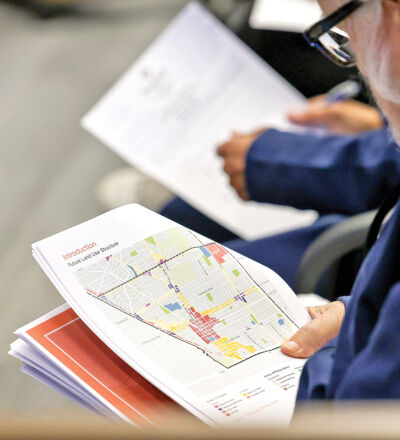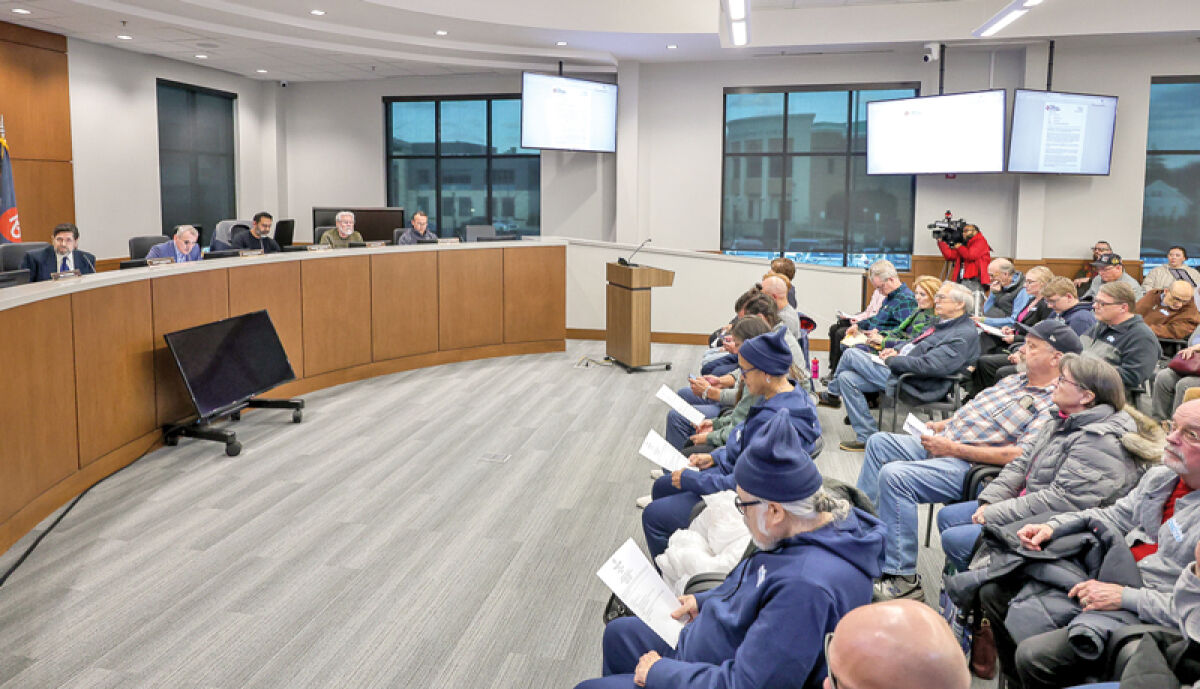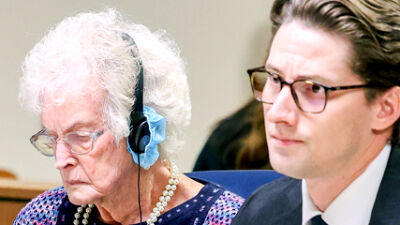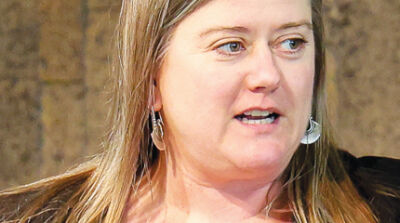
Residents packed the chambers and overflowed into the lobby to voice their opinions on the master plan draft during the meeting.
Photo by Patricia O’Blenes

Joseph Stephenson commented during the meeting, sharing that he did not approve of some of the plans listed in the master plan draft.
Photo by Patricia O’Blenes
ROYAL OAK — The public was called to City Hall during the April 8 Planning Commission meeting to voice their opinions about the proposed master plan of 2050.
The master plan was passed in a unanimous vote and is now going to be sent to the City Commission for further approval.
The proposed plan has seven goals listed in its introduction at planroyaloak.com.
The first goal is to reinforce the city’s historic structure through defining the character of places throughout the city.
The second goal is to advance sustainability and climate action by implementing the city’s Sustainability and Climate Action Plan.
The third goal is to provide more housing options through greater types of housing and supply. The third goal includes wanting to provide housing options for every stage of life.
The fourth goal is to preserve and enhance neighborhood character, which includes access to parks and retail areas.
The fifth goal is to reinforce activity centers, providing residents and visitors with destinations for shopping, dining, services and entertainment.
The sixth goal is to increase mobility across the city, ensuring that “people who walk, roll, bicycle, drive, or use public transit are well accommodated throughout Royal Oak.”
The final goal is to align policies, including Royal Oak’s future land use policy, zoning regulations, and other ordinances to produce the future city that residents and city leaders want.
Many of the residents who spoke during the April 8 Planning Commission meeting were unhappy with the proposed master plan, with few in support.
The master plan proposal removes the term “single-family homes,” which was a major issue for many of the residents who spoke at the public hearing. Instead of single-family homes, Royal Oak would just have neighborhoods.
“When you eliminate the single-family name, you can put anything you want in our neighborhoods, because that’s not single-family anymore,” resident Tom Hallock said in reference to section 1.3 Summary of Actions, section one in the master plan proposal.
Joseph Stevenson asked the Planning Commission to focus on affordable housing and mentioned his concern of the disregard for single-family homes.
“If we change the definition of single-family to neighborhood, it allows the development of (accessory dwelling units), it allows development of duplexes and triplexes and things like that,” Stevenson said. “That does not help affordability. That does not help aging in place.”
Alex Morford, a member of YIMBY Oakland County, spoke in favor of the master plan proposal, saying that she believes the plan was a good compromise to the residents’ wants.
“The commission and the consultants have listened to everyone and come up with this current proposed master plan that is a compromise of residents’ opinions,” Morford said. “I am here tonight to express my support for the proposed master plan. Moving forward with this proposed master plan is the next step for future Royal Oak with more housing and better infrastructure for everyone.”
“One of the reasons we loved the city and the area was due to the single-family neighborhoods, and a lot of that appeal, that was tied to the low-density residential structures that did define the community,” John Gist said. “By protecting the single-family homes, we are protecting the distinctiveness of the town, which led us to fall in love with it.”
The Planning Commission members discussed the next steps of the master plan draft following public comment.
Mayor Michael Fournier said that although people in public comment were asking for the decision to be made by the residents, that was impossible.
“The bulk of the work here is charged with the Planning Commission,” Fournier said.
Fournier said with his understanding of ordinances and how development works, he doesn’t see how the master plan draft would allow for developers to build apartment complexes within neighborhood communities.
“The fear is that developers could go and buy lots in, you know, off Main Street or any neighborhood, just buy three lots in any neighborhood and build a large multifamily apartment community,” Fournier said. “I can’t see how this master plan would allow that.”
Fournier asked the city attorney if that is a possibility, and how likely that would happen in Royal Oak.
“There are a number of different issues with that, and you still would have to go through a site plan approval, and in your scenario you’d have three separate plots, so those would have to be consolidated or you’d still have to comply with all of the setbacks, … So, theoretically, unless you went through all of those procedures, you’d have three different plots but you would only be able to put one house on each,” said Ryan Kaluzny, assistant city attorney for Royal Oak.
“The document says in so many words and sets as a goal to preserve and enhance neighborhood character, and then it physically defines on a map the areas that are neighborhoods and says we will preserve them,” Planning Commission member and City Commissioner Sharlan Douglas said.
Member of the Planning Commission Woody Gontina made a statement addressing some of the behavior at the public hearing, and his opinion on the master plan draft.
“The fact that residents are so engaged in their city is what makes us one of the strongest in the region, in my opinion. But yelling your opinion louder and more demonstratively than others does not make you any more correct than those that were more soft-spoken,” Gontina said. “This plan prioritizes sustainability; that means more than just things like energy and water efficiency, it means adapting to make sure that we have a city that stays strong and viable for future generations.”
The draft of the master plan was found to have errors including typos and grammar discrepancies; the council discussed the possibility of moving forward with the document with the errors.
Some members of the Planning Commission were OK with moving forward with the typos, saying that the small errors would not be detrimental to the plan itself.
“I’m going to quote Mr. Gontina, who used one of my favorite quotes, which is that perfect is the enemy of good enough,” Douglas said. “If there are commas misplaced, if there is a city council instead of a City Commission, is that fatal to the implementation of the plan? I don’t think so. So, I am not inclined to take any action and we’ve been at this for more than two years now.”
Jim Ellison, planning commissioner, said he would not like to see the document move forward to the City Commission if there are errors.
“We hired a firm to deliver us a document. I would expect that document to be correct. This document is not correct and I am hesitant to send it forward, because, you know, what else have we missed?” Ellison said.
Chairperson Gary Quesada said that he is not happy with the typos, but he would rather not add another step to the already long process it has been to create the 2050 master plan draft.
Timothy Thwing, Royal Oak director of community development, said that it is possible to send the draft to the City Commission with a list of the typo changes needed to be made within the document.
The Planning Commission unanimously voted to send the master plan draft with typos fixed to the City Commission. The changes are not going to change the content of the draft, only the typos and grammatical errors.
The full master plan proposal can be viewed at planroyaloak.com.
 Publication select ▼
Publication select ▼
























